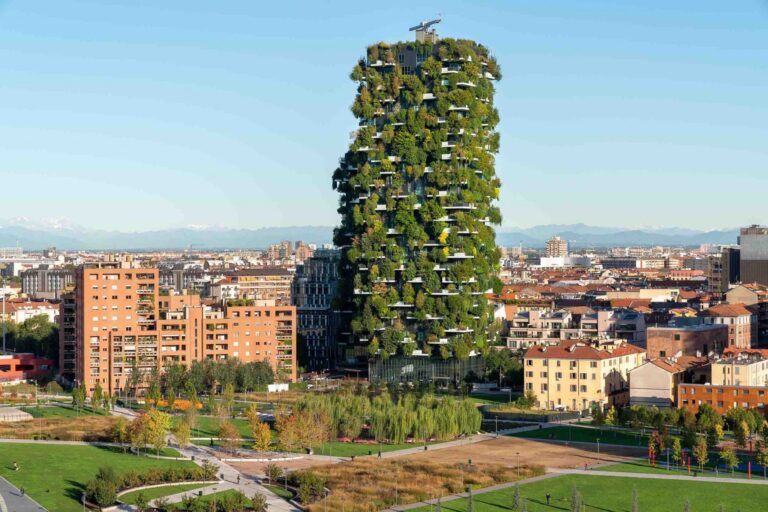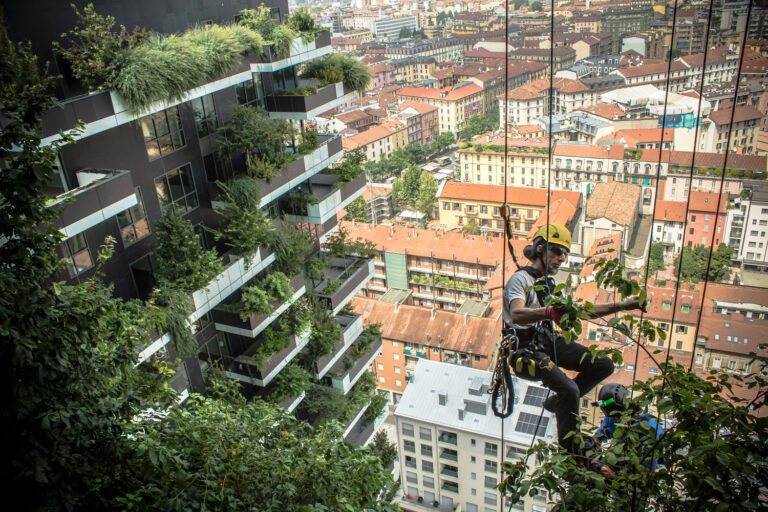Vertical Forest, a temporary trend or a long-term sustainable solution?
What is Vertical Forest?
Nowadays, when climate change issues are becoming increasingly complex, architects and urban designers are paying more attention to the sustainability of their projects. Boeri Studio’s Vertical Forest is a notable effort in this field in Milan, Italy. This is a complex of two residential skyscrapers and an 11-storey office building. The project was completed at the end of 2014 and has won many prestigious awards, including the International Highrise Award in 2014 and Best Tall Building Worldwide in 2015. Making a splash throughout the design community, this project attracted widespread interest and became a model for replication in many other countries. While it may seem like a trendy architectural concept, there are arguments both for its potential as a truly long-term sustainable solution and for considerations regarding the longevity of the building or operation.

Fig. 1 – The Bosco Verticale, by Stefano Boeri Architetti
The highlight of the project lies in the facade of the buildings, which it is almost completely covered with different types of trees, creating a beautiful aesthetic effect. The idea here is to replace traditional materials such as glass and metal on the building’s surface with a system of natural vegetation. By combining different seasonal plants, the project can create unique facades that continuously change depending on the time of year. This idea shows a completely different approach from a narrow technological and mechanical approach to achieving environmental sustainability.
Is it another trend-following project…
At first glance, the project may seem like a plan to follow the greening trend of recent years, but the vertical development of flora brings many microclimate and environmental benefits. Vertical Forests contribute to biodiversity and urban greenery, absorbing CO2, producing oxygen, and providing habitat for numerous types of birds and insects. These environmental benefits align with long-term sustainability goals, especially in densely populated urban areas with limited green spaces. In addition, the vegetation in Vertical Forests provides natural insulation, reducing the buildings’ energy needs for heating and cooling. This energy efficiency can contribute to long-term sustainability by reducing greenhouse gas emissions associated with building operations. The presence of greenery in Vertical Forests also enhances residents’ quality of life by improving air quality, reducing noise pollution, and providing opportunities for recreation and relaxation. These benefits contribute to the long-term sustainability of urban communities.


Fig .2 – Detailed Façade of The Bosco Verticale, by Stefano Boeri Architetti
…or a long-term sustainable solution?
Although the idea brings many benefits, there are still arguments surrounding the project about related issues. Vertical Forests require ongoing maintenance to ensure the health and vitality of the vegetation, including watering, pruning, and pest control. Without proper maintenance, the greenery may degrade over time, impacting the buildings’ sustainability and aesthetic appeal. Not to mention structural problems over time. Incorporating vegetation into vertical structures presents structural challenges, including additional weight and moisture management. Ensuring the structural integrity of Vertical Forests over the long term requires careful design and engineering solutions. Reality has clearly proven that. The project has been in operation for 10 years and has yet to have operational or structural problems. This requires a professional management and maintenance team to be able to operate the project for a long time. The cost for such a team is certainly not cheap, so sadly the people who benefit from the project will still be the upper class or the wealthy, who can actually pay for expensive projects.

Fig .3 – Maintenance activity, by Laura Cionci
Another issue that needs attention is the scalability and adaptability of the project. While Vertical Forests offer sustainable solutions for specific urban contexts, their scalability and adaptability to diverse climates, building typologies, and socioeconomic contexts may vary. Ensuring their long-term sustainability requires careful adaptation and integration into broader urban planning strategies. An unfortunate example of this concept is the vertical forest residential community in Chengdu, SW China, Sichuan Province. The project encountered an infestation of mosquitoes when it came into operation, making it impossible for people to live, and was abandoned. Now the buildings have been overrun by their plants.

Fig .4 – Abandoned housing project in Chengdu, China, by AFP
Conclusion
Overall, while the Vertical Forest concept may face challenges and considerations, it has the potential to be a long-term sustainable solution for urban development, especially when integrated with holistic approaches to sustainability, urban planning, and community engagement. As cities continue to grapple with environmental challenges and strive for more sustainable futures, Vertical Forests could play a valuable role in creating healthier, greener, and more resilient urban environments.
References
Fig .1 – The Bosco Verticale , by Stefano Boeri Architetti. Taken from: Bosco Verticale Milano. Available at: https://www.stefanoboeriarchitetti.net/project/bosco-verticale/. (Accessed: 18 May 2024).
Fig .2 – Detailed Façade of The Bosco Verticale, by Stefano Boeri Architetti. Taken from: Bosco Verticale Milano. Available at: https://www.stefanoboeriarchitetti.net/project/bosco-verticale/. (Accessed: 18 May 2024).
Fig .3 – Maintenance activity, by Laura Cionci. Taken from: Bosco Verticale / Boeri Studio. Available at: https://www.archdaily.com/777498/bosco-verticale-stefano-boeri-architetti. (Accessed: 18 May 2024).
Fig .4 – Abandoned housing project in Chengdu, China, by AFP. Taken from: Residents shun Chinese ‘vertical forest’ housing project because the trees meant to revolutionize urban living have attracted plagues of mosquitos. Available at: https://www.dailymail.co.uk/news/article-8737341/Residents-shun-Chinese-vertical-forest-housing-project-attracted-plagues-mosquitos.html. (Accessed: 18 May 2024).
Boeri, S. (2015). A Vertical Forest | Instructions booklet for the prototype of a forest city. Available at: https://books.google.co.uk/books/about/A_Vertical_Forest.html?id=gNVbjwEACAAJ&redir_esc=y. (Accessed: 18 May 2024).
Steinbuch, Y. (2020). Mosquitoes overrun Chinese apartment complex turned into ‘vertical forest’. Online: New York Post. Available at: https://nypost.com/2020/09/15/mosquitoes-overrun-chinese-complex-turned-into-vertical-forest/. (Accessed: 18 May 2024).








The fact that vertical gardens are a contrasting feature that adds greenery and vegetation to high rise buildings is an interesting factor that i am fascinated by. While the benefits are immense, some challenges and concerns remain, such as sustainability and so on.
On the positive end, vertical gardens have biophilic benefits and reduce noise and excess heat (Giacomello and Valagussa, 2015). This reduces the energy consumption of the building.
However, maintaining this solution for the long term is one of the key challenges, as the system does require extensive resources such as watering, pest control, and so on at regular intervals (Steinbuch, 2020).
Overall, while vertical gardens may woo the crowd, they are nothing more than an architectural smoke and mirror trick until a truly sustainable and cost effective approach is considered.
References:
Giacomello, E. and Valagussa, M. (2015) ‘Vertical Greenery: Evaluating the High-Rise Vegetation of the Bosco Verticale, Milan’, CTBUH Research Paper.
Steinbuch, Y. (2020) Mosquitoes overrun Chinese apartment complex turned into ‘vertical forest’, New York Post. Available at: https://nypost.com/2020/09/15/mosquitoes-overrun-chinese-complex-turned-into-vertical-forest/